October 5, 2011
I came to California this week to attend Apple’s iPhone event, but I also stopped by to see the guys at BAMM.TV.
Being a musician and a fan, I was interested in what this new company was doing to help artists and bands gain popularity and momentum in their careers. The quick answer — they’re doing a lot.
The basic story is this: BAMM works with the artist to record HD videos of a few of their songs at no cost to the band. The company then has exclusive worldwide distribution rights for the videos.
Through their partnerships with cable companies and mobile companies like Samsung, users are able to purchase subscriptions and the individual videos.
You might think that the publicity for the bands would be incredible, and it is, but BAMM takes it a step further. BAMM shares any profits with the artist 50/50, so the band gets exposure, but the also get paid.
I’ll have a more in-depth story on BAMM in the coming weeks, but I was so impressed with what I saw, I wanted to let everyone know.
Mark my words, you’ll be hearing a lot from these guys.
Written by Jim Dalrymple
Reuters:
Microsoft Corp is considering a bid for Yahoo Inc, resurfacing as a potential buyer after a bitter and unsuccessful fight to take over the Internet company in 2008, sources close to the situation said on Wednesday.
Microsoft is the latest name to be thrown in the hat for a possible Yahoo acquisition. Other companies include Alibaba, DST Global and Providence Equity Partners.
Written by Jim Dalrymple
AllThingsD:
Though it might seem more incremental upgrade than new iPhone, Wall Street analysts say Apple’s iPhone 4S isn’t nearly the disappointment that some claim. And while its unveiling without the simultaneous debut of the iPhone 5 caused investors some knee-jerk dismay, consensus seems to be that it will likely prove another big step forward for the device and the platform on which it runs.
John Paczkowski digs into what analysts actually said about the iPhone 4S yesterday, and while some offer comments to support news coverage expressing disappointment with the lack of a complete case overhaul, more complete commentary from analysts like Mark Moskowitz reveal that even they think the under-the-hood enhancements will be a big deal for Apple customers.
Written by Jim Dalrymple
Dean Bubley’s Disruptive Wireless:
What Apple has actually been doing is working on a new hardware platform which will probably endure for several generations of its devices. That has likely taken a *huge* amount of work: chipset and hardware level integration is massively complex and needs lots of fine-tuning.
Some really good insights here about the complexity involved in Apple’s chip engineering, and what’s needed from its suppliers. (Hat tip to Chad Olson.)
Written by Jim Dalrymple
GigaOM:
Samsung revealed on Wednesday that it would try to stop the release of Apple’s new iPhone 4S in France and Italy with filings seeking injunctions on the new smartphone. Samsung’s complaints (via WSJ) will center on two instances of alleged patent infringement related to WCDMA standards for 3G connectivity.
Samsung is unlikely to have caught Apple unaware with this move; chances are that Apple’s legal team already has planned a counterstrategy.
Written by Jim Dalrymple
ZDNet:
You might have noticed in the run up to the new iPhone release (which turned out to be the iPhone 4S and not the iPhone 5) that certain tech outlets spent a lot of time telling you what Apple’s next iPhone was going to be like.Turns out only Apple knew what the next iPhone was going to look like.
Adrian Kingsley-Hughes spends the next several paragraphs rounding up some of the biggest howlers posted in advance of yesterday’s announcement, including that Sprint was going to get an iPhone 5 exclusive, that Apple planned to release two phones, Facebook iPad app launch and more.
October 4, 2011
After introducing the iPhone 4S on Tuesday, many of Apple’s Web sites around the world updated with information about Siri, Apple’s new voice assistant technology. One that was missing was Canada.
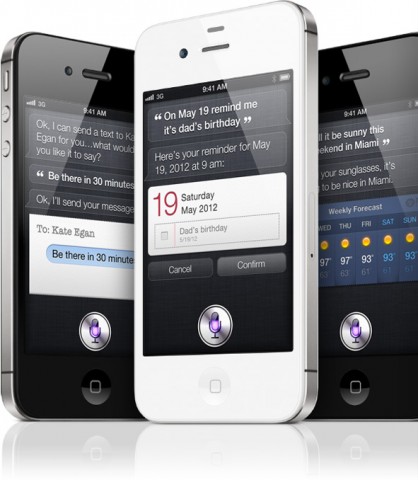
Many have become concerned that Siri will not be available in Canada, but it will. I’ve confirmed with Apple that Canadian users will be able to turn on Siri on their phones.
Siri is localized in US, UK and Australia, French and German. The company didn’t specifically use Canadian in the technology, but it worked just fine for me.
I used Siri on an iPhone 4S for a little while this morning using the US version and it understood all of my commands, so Canadians shouldn’t have a problem when it’s released.
If you’re in the US and you use Verizon or AT&T for your cell phone carrier, you may be wondering if you’re eligible for an upgrade and how much it will cost to get a shiny new iPhone 4. Apple can help you out – they’ve posted a Web page to help you check.
Right now the page checks your account status on AT&T or Verizon, depending on your carrier, but Apple notes that Sprint is coming soon.
Interestingly, Apple’s beaten AT&T to the punch – we tried to check on AT&T’s Web site earlier today but couldn’t get any information about the iPhone 4S.
By now you’ve probably read coverage of Tuesday’s “Let’s Talk iPhone” event at Apple’s Cupertino campus, where Tim Cook and company took the wraps off of the new iPhone 4S, refreshed iPod touch and iPod nano models, and put a release date (next Wednesday) on iOS 5 and iCloud.
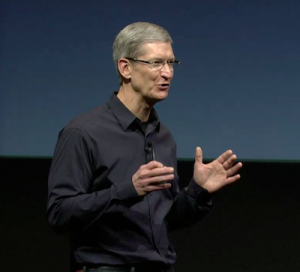
But now you can
view it for yourself. Apple has posted a link on its Web site that lets you view a replay of the keynote – featuring Tim Cook on stage as Apple’s permanent CEO for the first time. The video requires Safari 4 or 5 on Mac OS X Snow Leopard or Lion, Safari on iOS 3 or later, or QuickTime 7 on Windows.
Apple on Tuesday introduced updated iPod touch and iPod nano models. The iPod touch now starts at $199, while the iPod nano costs $129.
The new iPod touch, which ships on October 12, 2011. It comes in 8GB, 32GB and 64GB models for $199, $299 and $399 respectively. It comes in either white or black, like the iPhone 4S.
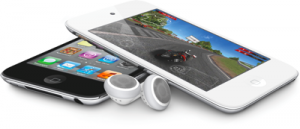
While the color is the only noteworthy external change, the iPod touch is different under the hood. It comes pre-installed with iOS 5, which Apple counts as having more than 200 improvements. iPod touch supports iMessage, new Notification Center, Game Center improvements, Wi-Fi Syncing and all the other enhancements available in iOS 5, which will also be released as a free update for all eligible users on Wednesday.
The iPod nano has new, larger icons for easier navigation. Apple has acknowledged that many users of the previous iPod nano use the device as a watch; the refreshed model has 16 new digital clock faces, including an analog design that makes it look like a Mickey or Minnie Mouse watch. The iPod nano now tracks your runs and walks without requiring a separate sensor, and comes in seven colors – silver, graphite, blue, green, orange, pink and red (part of the PRODUCT (RED) charity program).
The company also indicated, contrary to media reports, that the click-wheel iPod classic remains available. The click-wheel iPod costs $249 and comes in one model – a silver 160GB unit. The shuffle remains part of the lineup as well, available in a 2GB version in five different colors, each for $49.
Apple on Tuesday announced that iOS 5 and its new iCloud service will both be available on Wednesday, October 12, 2011. iOS 5 is a free update for all eligible iOS devices and iCloud is also free, though Apple offers subscription tiers for users who require extra storage space.
iOS 5
Apple counts more than 200 new features in iOS 5. Among them are iMessage, an integrated text messaging service that lets you send text, videos, photos locations and contacts; Notification Center, a reworked notification system that helps you keep track of all app notifications in one place.
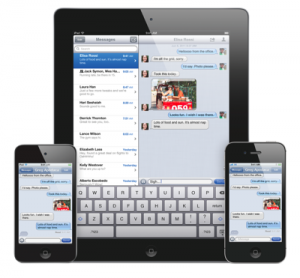
Newsstand organizes newspaper and magazine subscriptions much in the same way that iBooks keep tracks of e-books, and automatically downloads new issues in the background. A new Reminders feature lets you organize to-do lists that can be date or location-bound.
Twitter, the popular microblogging service, has been integrated into iOS 5, so you can now tweet directly from Safari, Photos, Camera, YouTube or Maps. Contacts now applies your friends’ Twitter handles and profile pictures, and iOS 5 can also add locations to tweets.
iOS 5 improves photo management with support for cropping, rotation, built-in enhancements and red-eye removal. Safari now supports tabbed browsing, adds a Reading List feature for later reading, blocks ads, and improves performance.
Wi-Fi Sync is another key feature of iOS 5 – it enables you to synchronize iOS device content with a Mac or PC over a shared Wi-Fi connection. Each time you connect your iOS device to a power source, it automatically syncs and backs up content to iTunes.
Mail, Calendar, Game Center and other aspects of iOS have gotten overhauls, too.
iOS 5 will be available for iPhone 4, iPhone 3GS, iPad 2, iPad and iPod touch (third and fourth generation) models. It’ll also come preinstalled on the iPhone 4S, which will be released on Friday, October 14, 2011.
iCloud
iCloud is a suite of interconnected cloud-based services that include iTunes in the Cloud, Photo Stream and Documents in the Cloud. They’re designed to help Mac and PC users automatically and wirelessly share and store content with iOS devices including the iPhone, iPad and iPod touch.
iTunes in the Cloud lets you automatically download new music to all your devices without having to manually sync them to a computer. You can download music and TV shows, including previously purchased content.
iTunes in the Cloud is free, but another music-related cloud service, iTunes Match, will set you back $24.99 per year. The software scans the content of your music library and matches it to the music available on the iTunes Store. Music that doesn’t match is automatically uploaded, so you can play any of your music on any of your iOS devices.
Photo Stream makes it possible to take a photo on one device and have it automatically appear on other devices; a photo taken from your iPhone is sent to iCloud, distributed to your computer and other iOS devices, or shared on your Apple TV using a Photo Stream album. It will show your last 1,000 photos, and pushes copies of photos you’ve imported from a digital camera over Wi-Fi or Ethernet.
Documents in the Cloud helps keep iWork documents (Pages, Keynote and Numbers) in sync across devices. Apple is offering up the Application Programming Interface (API) to third-party developers to encourage support in their own applications. And iCloud Backup securely backs up content daily over Wi-Fi, whenever your iOS device is connected to a power source.
Find My Friends is a new app you’ll be able to download for free form the App Store that will let you share your location with select groups of people – friends and family with access to the info can see where you are; you get notifications when you get new friend requests. It also supports parental controls, so parents can keep an eye on wayward children (and limit their usage of Find My Friends).
iCloud is free, but only comes with 5GB of storage. 10GB, 20GB and 50GB storage upgrades are available for $20, $40 or $100 per year respectively.
I just spent about 30 minutes with Apple’s iPhone 4S and thought I’d give you my initial thoughts.
First the iPhone 4S is exactly the same size as the existing iPhone 4. I laid my iPhone on top of the iPhone 4S and there were no discernible changes to the design.
Even the rounded corners of the device were the same. Length, width and height all seem to be identical on the devices.

What is a bit different are the number of black bands that are on the iPhones. The current model has three bands — one on each side on the bottom, and one on the top. The iPhone 4S has four bands — two on the top and two on the bottom.
The bands are where Apple houses the antennas for the device. The Wi-Fi, wireless and Bluetooth technologies use these areas. It’s not clear at this point if Apple moved any antennas or what they added the extra band.
The real big difference with the iPhone 4S is with its processing power. Of course, having the A5 processor is huge, because it can easily handle Apple’s more advanced technology like its voice assistant, Siri.
The increased processing power also allows developers to continue to push the envelope on the complexity of apps that are built for gaming, productivity and other applications.
Overall, the power of the iPhone 4S is impressive. Being able to use apps like Siri will be fun, but we’ll have to wait to see what coverage and call quality are like.
Apple on Tuesday introduced the iPhone 4S. The new phone comes out on Friday, October 14, 2011 and will be available in 16GB, 32GB and 64GB models. Carrier-subsidized prices in the US are $199, $299 and $399 respectively. It comes in black or white.
While externally similar to the iPhone 4, the iPhone 4S features a dual-core A5 microprocessor inside, the same kind used in the iPad 2. This nets a 7x speed improvement to graphics and a 2x overall speed improvement to CPU-dependent tasks, according to Apple. The battery lasts for up to eight hours of talk time on a 3G network.
One of the major new enhancements capable with the iPhone 4S’s improved processor performance is Siri, a built-in “intelligent assistant” that can respond to you when you ask the phone questions or give it commands, such as locating a restaurant, getting weather reports or directions, or making an appointment. It can also help send text messages, perform complex calculations and more.
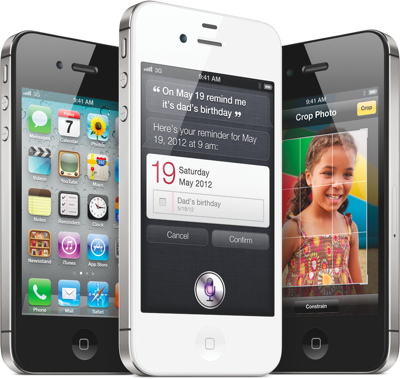
A dramatically improved camera takes 8 megapixel still images and records 1080p HD video with image stabilization. Apple says the camera features a hybrid infrared filter and an effective f/2.4 aperture, making it better suited to take pictures in low light. It also takes pictures faster, and has a shot-to-shot capability twice as fast as its predecessor.
The steel band antenna surrounding the phone uses what Apple describes as an “intelligently switching” design to send and receive data and voice communications; likely redesigned in the wake of the iPhone 4’s apparent antenna-related issues. It also comes as a “world phone,” able to operate on both GSM and CDMA bands. The iPhone 4S can also download data on HSDPA networks at up to 14.4 megabits per second – twice as fast as the iPhone 4, though still short of the speeds of LTE networks currently in early deployment by Verizon and AT&T.
The iPhone 4S is the first iPhone to feature iOS 5 out of the box. Apple counts over 200 improvements in iOS 5, including Notification Center and iMessage, a new integrated messaging service. iOS 5 also supports iCloud, Apple’s new cloud-based services to replace most of what it has offered with MobileMe.
In related news, Apple announced that the iPhone 3GS and iPhone 4 remain available for sale after the iPhone 4S’s launch. The iPhone 3GS will now become available for free with a two-year contract, while the iPhone 4 will be relegated to a single 8GB model for $99 with a two-year contract.
Apple has also announced that with the iPhone 4S’s launch, the U.S. cell carrier Sprint will now carry the phone.
We are live at the event. (more…)
Written by Jim Dalrymple
Reuters:
Apple Inc rejected an offer from Samsung Electronics Co to settle their tablet computer dispute in Australia, possibly killing off the commercial viability of the South Korean firm’s new Galaxy tablet in that market.
Last week Samsung agreed to withdraw features from the Galaxy 10.1, but that isn’t enough for Apple, which claims that Samsung “slavishly” copied features from the iPhone and iPad for its own Galaxy devices. Apple, which has already received injunctions in European courts to prevent Samsung from selling its devices there, thinks it’ll fare better in front of a judge. Samsung, for its part, says it’s make or break time – the company suggested that if it can’t work out an arrangement to get the Galaxy Tab 10.1 on the market soon, the product will be “commercial dead” anyway.
Written by Jim Dalrymple
WinRumors:
Microsoft has officially confirmed the death of its Zune player devices.The software giant removed references to the Zune HD from its Zune site on Monday and later claimed that the removal was “a mistake.” It appears that the reference removals may have been planned for later but were mistakenly pushed early. A new support article on Microsoft’s Zune support pages makes it very clear…
The writing has been on the wall for months, so no one should be surprised by this. Microsoft never got the traction with Zune that it hoped for and expected. Why? Well, it just didn’t have a very good product. Now even Apple’s stranglehold on the MP3 player market is diminishing as fewer customers buy devices specifically designed to play music, instead opting for fully-featured devices with more capabilities.
October 3, 2011
Written by Jim Dalrymple
The Mac mini is too small.
The Mac mini is going to be killed by Apple.
The Mac mini isn’t meant to be a server.
Seven years and thousands of Mac minis later, Macminicolo remains the original and largest Mac mini hosting company. The Mac mini “has become Apple’s most popular server system.”
Readers of The Loop can signup for a six month Ultimate Trial for just $10/mo. Come see what a Mac mini can do. Signup here
Written by Jim Dalrymple
9to5Mac:
In case there was any question, we’ve heard directly from Apple PR that there won’t be a webcast of Apple’s iPhone launch event.
That shouldn’t matter, because The Loop will be there, and we’ll be covering the event live. Check with us for coverage when the event kicks off Tuesday at 10AM Pacific, 1PM Eastern.
Adobe CTO Kevin Lynch announced at the company’s MAX 2011 conference in Los Angeles on Tuesday that Adobe has acquired Typekit, a subscription-based online font service.
Typekit enables Web designers to legally license and embed typefaces on their Web pages. The service currently counts over 250,000 customers, including major publishers like The New York Times, Condé Nast and IGN.
Adobe said that Typekit will be offered as a standalone service, and will eventually also be offered as part of Adobe’s Creative Cloud service. Creative Cloud is a new Adobe initiative also announced by Lynch at his MAX keynote.
In a blog post, Typekit creator Jeffrey Veen said of Adobe, “There honestly is no better place for us to continue building our platform.”
Music service Rhapsody on Monday announced plans to acquire Napster, most recently owned by Best Buy. Terms of the agreement were not announced, but Rhapsody indicated that Best Buy gets a minority stake in Rhapsody after the deal is done.
Rhapsody and Napster both provide subscription-based on-demand music services. They bill themselves as the two largest such services in the United States. The deal helps bolster Rhapsody against Spotify, the European-based music streaming service which earlier this year began offering access to customers in the US.
“This is a ‘go big or go home’ business, so our focus is on sustainably growing the company,” said Jon Irwin, Rhapsody’s president.
Spotify found itself in the crosshairs recently after the company instituted a policy requiring customers to sign in using Facebook. The policy shift hasn’t hurt Spotify – the company said that two million users have joined on since then, bringing the total user base to more than five million. Those two million new users are using both Spotify’s free and pay services.
Written by Jim Dalrymple
The Joy of Tech:
What’s behind a Tim Cook Apple EventGiant clipping robot, (in case Jim Dalrymple’s beard gets rowdy).
Much respect JoT!
Written by Jim Dalrymple
Technologizer:
More than thirteen months after we ran that iPadversaries story, I decided it might be instructive (or at least perversely fascinating) to follow up on all 32 machines… Spoiler: If you like happy endings, you should stop reading now.
In retrospect, it’s almost comical how bad some of these products fared in the market. And in some cases, at least, it’s not a matter of a company bringing a lousy product to market, either – marketing missteps and fundamental misunderstands of how consumers use these devices seem to be prevalent themes.
Written by Jim Dalrymple
Fortune:
When measured against other smartphone/tablet operating systems, Apple’s (AAPL) iOS accounts for more than half of the visits to its clients’ 40,000 websites around the world. In fact,the 54.65% share that Net Applications recorded for iOS devices in September is an all-time record.
Although the overall global marketshare of Android phones is closing in on 50 percent, it seems that many users don’t use their Android phones to surf the Web. RIM is in the dust, garnering less than 4 percent share.
Written by Jim Dalrymple
Bloomberg:
Apple, which will introduce a new iPhone version tomorrow, ships fewer handsets to the world’s second-largest mobile-phone market than it does to Norway. Nokia Oyj and Research In Motion Ltd. sell more devices in India, where smartphone shipments are forecast to grow almost 70 percent a year until 2015, helping mitigate their market-share losses in the U.S. and Europe. Sales for the world’s biggest company by market value are hindered because Indian wireless carriers, which started third- generation networks this year, have yet to offer nationwide services fast enough to take advantage of iPhone features, said Gus Papageorgiou, an analyst at Scotia Capital Inc. in Toronto.
Many in the US are ready to discount Nokia – which is transitioning its product line to Windows Phone 7-based devices – and RIM, but they forget there’s a big chunk of the world where Apple is still a relatively minor player. They do so at their peril. Markets like India are huge, and they’re areas ripe for competition from companies that can offer competitive products at prices local consumers can afford.
September 30, 2011
Written by Jim Dalrymple
I’d like to thank App Cubby for sponsoring this week’s RSS feed on The Loop.
Keep an eye on App Cubby, the best is yet to come.
I posted my review of Avid’s Eleven Rack guitar amp and effects processor back in August, giving users an overview of my thoughts. Since then readers have been writing, asking all kinds of questions.
I’ve taken the most asked questions and my answers below.
Would you trade in your amp for the Eleven Rack?
No. But you need to understand, I don’t get rid of any piece of gear. I’ve still got pedals from the 80s, and I fire them up once in a while too. For me, gear is like a treasure and I just can’t bring myself to get rid of any of it.
Currently I have 15 guitars, 8 amps, half a dozen pedals, and countless USB and FireWire interfaces. Depending on my mood and the type of music I’m playing, I could break out any combination of those and be perfectly happy.
Is it easy to see in low light?
It’s great in low light situations. The screen is lit, but even better — and in my opinion, more important — the knobs are well lit. This means you can see what level the settings are on from a good distance from the unit. If you need to make a quick adjustment to your amp tone, you can just shuffle over and turn the knob.
Like amp knobs, the Eleven Rack comes with large knobs that are well spaced, so your fingers can grab it and make the adjustment.
What it’s like with different guitars?
I tried the Eleven Rack with a number of guitars. Mostly, a Les Paul with EMG 81/85, Fender Strat, Jackson, and a Taylor SolidBody. Obviously, lots of different types of music in there.
What impressed me the most is that they all sounded like they were supposed to sound. The Eleven Rack didn’t try to make the guitar something it’s not, but rather just let it be what it is.
How accurate is the amp modeling?
I’m impressed with the modeling for sure. There are little nuances that you get to know about your amps and how it reacts to different things. Even running your hands over the strings gives you a certain feel on a real amp.
Not every amp is the same, so it would be impossible for the modeling to capture my exact Marshall JCM 800, but I do get that feel from the Eleven Rack. I know when I turn on a preset and it has an 800 amp. That’s pretty impressive.
How about the effects?
When I’m in my studio, I tend to put most of the effects on after I record. However, for live situations, I did use the effects on the Eleven Rack and they easily met my expectations.
Avid included some of the classic models of delays and distortion, so you’ll know right away what you’re putting on your tone.
To be honest, the more years that I play, the more I like to find the right amp for the tone instead of piling on effects.
Do you use Eleven Rack with an amp or by itself?
I did everything with it. I had the Eleven Rack plugged into my JCM 800’s front input, I had it going through the effects loop of my 5150, and I had it going straight into my Mackie 1640 and out through the PA speakers.
What was really fun was running the stereo outs to the board and then running one of the Eleven Rack’s amp outs to the 800 or 5150. Now that just lights up your tone.
It takes a little tweaking to get a setup like that sounding just right though. It all depends on your personal tastes, but I liked having the amp drive most of the tone with the PA bringing up some of the undertones.
Do you need a computer to make changes?
Not at all. You can use the Eleven Rack interface included in Pro Tools, but you can also do everything you need to on the hardware unit itself. Whatever changes you make on one is reflected in the other.
Written by Jim Dalrymple
Text can be resized, selected, bookmarked and shared with social media, and even read aloud by the iPad. Flick through the images in the easy to follow How to section and the steps change automatically and, if you need more help getting started with your iPad, a series of friendly video guides will turn you into an expert in no time.
This is the best implementation of a magazine I’ve seen on the iPad yet.
Written by Jim Dalrymple
AppleInsider:
Users used to be able to access a link to “iPod Click Wheel Games” by clicking the drop-down menu on the App Store link in iTunes. But now, that option has disappeared from the menu.
Rumors suggest that Apple is discontinuing the click-wheel iPod Classic. It seems obvious that an iPod touch with similar storage capacity (128GB) will ultimately replace it, though such a device hasn’t shown up in the store yet.
No new software has appeared for the iPod Classic in some time, but I don’t understand why Apple would remove existing apps from the App Store – what harm is there in keeping it on? I still have an iPod Classic that gets use on long road trips – it’s the only thing big enough to support my entire iTunes library. I’ve spoken with other users who still depend on theirs too, so I know they’re in use.
It’s beards, you know it’s going to be funny.
Written by Jim Dalrymple
VentureBeat:
A well-placed source tells us that HP is currently looking to rid itself of Palm as soon as possible, and that Amazon is the closest to finalizing the deal, among a handful of contenders.
If true, it means that HP’s new CEO is also ready to give up on any kind of mobile strategy for the company. I still think webOS is a great mobile operating system and in the right hands, it could help pull a company into second place in the tablet market.






